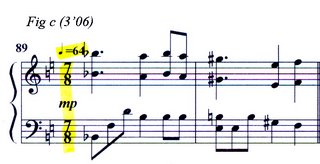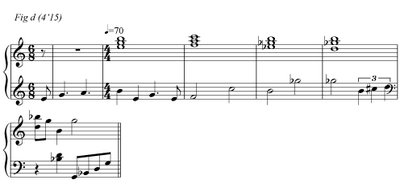Generally, although frequent changes in time signature occurs, listeners would still be able to feel the pulse/ beats of the music since regular rhythms such as semiquavers and quavers are used in abundance.
For instance, starting from bar 42, just by listening to the music without looking at the scores, listeners may first be deceived into thinking that the music has changed from 2/4 into 6/8 time due to the introduction of distinct dance/ waltz – like feel in the melodic and accompaniment pattern. However as one listens on, one senses the unevenness in pulse of the music (i.e. some bars have a beat more or less than 6/8).
Actual sequence of meter employed:
Starting from bar 42, the music passes through 7/8 (b.42-44), 5/8 (b.45), 6/8 (b.46-47), 7/8 (b.48), 6/8 (b.49-54) and then alternating each bar with 3/8 and 6/8 meter from bars 55-59.
As seen, the central time signature is 6/8, but the composer plays with our expectation by ingeniously adding or removing a quaver beat every few bars.
There are also instances, especially in linking passages where the sense of pulse becomes obscured to the listener. Such as in bars 89 – 90 (Fig c) and bars 116 beat 4 – 122 (Fig d) where the music seems to be suspended in time. This is achieved by rubato and the usage of longer valued notes coupled by changes in tempo.


No comments:
Post a Comment